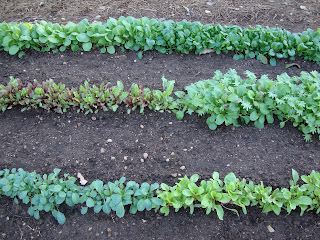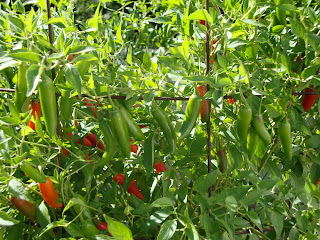 |
| Chinese tallow leaves (Sapium sebiferum) in fall |
The bad news about the Chinese tallow tree (Sapium sebiferum) is that it is non-native and invasive. And it's not simply invasive as in occasionally escapes from cultivation, but invasive as in a real problem. The Chinese tallow tree was imported into South Carolina in the 1700's, where it quickly naturalized and spread up the Atlantic Coast and across the Gulf Coast to Texas. The invasive tree has also spread to California, where it is listed as a "red alert" pest plant. In Florida, where the Chinese tallow tree clogs waterways and ditches, planting or moving the trees is prohibited. Nonetheless, the tree is still available at nurseries throughout the southern United States, where it is sold as an ornamental and promoted for its fall foliage.
 |
| Chinese tallow tree (Sapium sebiferum) in fall |
In Texas, Chinese tallow tree has taken over the coastal plains, replacing the grasses and wildflowers that once supported a diversity of insects and animals with single-species forests. Almost a quarter (23%) of the trees in the Houston area are now Chinese tallow trees. In the United States, the Chinese tallow tree is very fast growing, which contributes to its ability to take over pastures and disturbed areas. Ecologists studying the tallow trees believe that trees are able to grow so quickly because they lack insect pests here in the US, and therefore do not have to manufacture insect-repelling compounds but can instead direct all of their energy into growth. In Asia, where the Chinese tallow tree is native and has insect pests, the trees grow much more slowly.
Another non-native, invasive tree that contributes to the fall-color landscape is the Tree of Heaven, the colors of which can be seen along the shores of Ladybird Lake downtown or in vacant lots throughout town. While the Tree of Heaven (Alianthus altissima) does not have leaves that turn colors, the female trees are covered in red-tinted samaras in the fall. Samaras are flattened, aerodynamic fruits, like the flyers of maple trees, that carry the seeds away from the parent tree. Huge clumps of reddish samaras, in contrast with the green foliage of the trees, create striking fall color.
 |
| Tree of Heaven (Alianthus altissima) with samaras |
Unfortunately, each of those pretty samaras carries a seed for an invasive pest of a tree that, like the Chinese tallow tree, is fast-growing, soft-wooded, and does not feed or protect any of our native birds and butterflies. I have always wished that the Tree of Heaven had a different, less positive sounding name. In reading about the tree I learned that some people call it the "ghetto palm," which sounds like a perfect name to me. I imagine that it would be much easier to cut down and poison, as is suggested on many native plant websites, a Ghetto Palm than do the same to a Tree of Heaven.
So where is the native display of Texas fall color?
One option is to travel to Lost Maples State Park, which protects a relic maple forest left from a cooler and/or wetter time. Which points to the reason why we don't have a lot of fall color in the first place - aside from a few maples in a park, we don't have the right trees. Fall color is produced by temperate, deciduous trees. In central Texas we have a mix of semi-tropical trees (like mesquite and acacia), evergreen trees (like cedar and live oak), and temperate, deciduous trees (like cedar elm and pecan).
Most of our temperate, deciduous trees turn yellow, not red, in the fall. This is not because the conditions aren't right for red leaves here because, actually, our sunny fall days are perfect for red-leaf production. The leaves of cedar elms, pecans, hackberries, and mulberries turn yellow because those trees don't have the genetic ability to make red leaves. In fact, only about 10% of temperate trees do have the ability to make anthocyanins, or the red to purple pigments that are so prized in fall foliage. New England, famous for its fall color, just happens to have a very high concentration (up to 70%) of trees that have the ability to make red leaves.
The leaves of temperate trees are green throughout the spring, summer, and, in Texas, much of the fall because the leaves are full of green-pigmented chloroplasts, which are busy capturing the energy of the sun to make sugar for the plant. Auxiliary pigments that help in light capturing or protect the leaves from certain parts of light, such as yellow xanthophylls and orange carotenoids, are also present in the leaves throughout the season. In the fall, shorter days or longer nights cue the tree to store sugar in its roots and to stop auxin production, which causes a layer of cork cells to form between each leaf and tree branch, so that the leaf no longer gets water and nutrients. The chloroplasts in the leaf are broken down and, as the green pigment of the leaf disappears, the yellows, oranges, and browns of the auxiliary pigments become visible, producing fall leaf color. In a few species of trees, such as maples and oaks, sunny fall days also stimulate the production of red to purple pigments, which, unlike the auxiliary pigments, are not present throughout the season.
Virginia creeper (Parthenocissus quinquefolia), a vine that grows throughout the eastern United States and is native to the streamside forests of east and central Texas, has leaves-of-five that turn deep red in the fall. I found this example of striking, and native!, fall foliage in downtown Austin.
 |
| Virginia creeper (Parthenocissus quinquefolia) leaves in fall |
Another native vine, poison ivy, has leaves-of-three that also turn yellow, orange, and red in the fall. Poison ivy (Toxicodendron radicans), though native, is invasive in the sense that it is a species that thrives in disturbed habitats. According to urban legend, over-enthusiastic suburban housewives occasionally make holiday centerpieces out of the attractive fall-colored vines. I imagine it's not a mistake that is made twice in any given neighborhood.
 |
| Poison Ivy (Toxicodendron radicans) on a pecan tree in fall |
Finally, we do have a magnificent tree that the New Englanders can't claim that gives us four-season beauty - the Bald Cypress tree. Unique among the conifers, Bald Cypress (Taxodium distichum) is not evergreen but drops its leaves each fall. The feathery leaves turn yellow, or orange, or rust-colored before falling, and the different rates of the trees in turning color and dropping their leaves create variegated fall color along the rivers and streams of our area.
 |
| Bald Cypress (Taxodium distichum) in fall |
















































